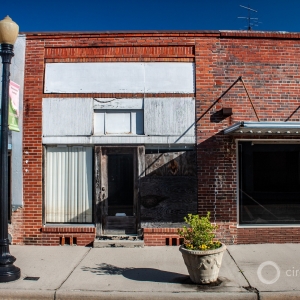Two Hurricanes, Two Floods: North Carolina Town Fights To Stay Alive
By Brett Walton, Circle of Blue – June 5, 2019
In tale of its time, Fair Bluff is buckled by ecological turmoil.
FAIR BLUFF, N.C. – U.S. Route 76, which connects inland South Carolina to Wilmington and North Carolina beaches, carries a steady stream of traffic on a late April afternoon. But besides gas and groceries, travelers have little reason to stop in this anguished town. For that matter, neither do its few remaining residents.
A crossroads community on the left bank of the Lumber River, Fair Bluff was hit by two spirit-buckling punches in the last three years. In October 2016, Hurricane Matthew flooded the two-block business district on Main Street with four feet of water. And again last September, floodwaters rose a few inches higher during Hurricane Florence, which broke rainfall records across southeastern North Carolina.
The black waters that poured out of the Lumber River during both storms claimed other assets, too. A mile-long boardwalk across the cypress and tupelo swamp that borders the river, Fair Bluff’s main tourist attraction, is mostly closed. Some 71 homes and an apartment complex were flooded. Half of the homes will be demolished with the help of federal grants. Until the money arrives, they are left to rot. Fair Bluff Baptist Church, on the south end of Main Street, had just completed $435,000 in repairs from Matthew when Florence hit and flooded it again. The church has no flood insurance and relied on donations to fix its sanctuary and educational building.
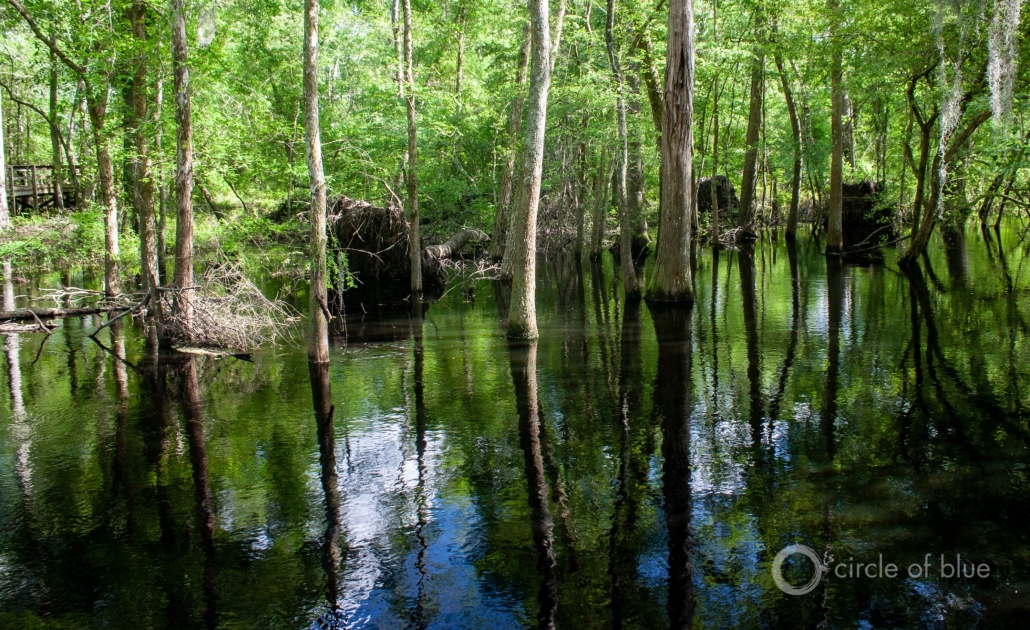
The Lumber River, its waters dark and tannic, flows along the northwest side of Fair Bluff. The river flooded Main Street, just a block away, during hurricanes Matthew and Florence. Photo © Brett Walton/Circle of Blue
If there is any solace at all, the storms did not claim a life. But the twin calamities crushed souls in a small town already being eroded by economic, demographic, and technological trends that are causing a slow motion disaster in rural America. Home to nearly 1,200 people two decades ago and some 900 people before the storms, Fair Bluff now has about 600 residents, according to Al Leonard, the part-time town manager. The town lacks the financial reserves and economic footing to rebuild on its own. Its tax base is shrinking. Its aging sewer system, overwhelmed by underground infiltration, was such a financial drain that the town bank account was overdrawn at one point. Median household income is $27,898. Numerous residents who were asked to reflect on changes since the storms called Fair Bluff a “dead town.” There’s no bank. No hardware store. Few places for commerce.
Though it was hit by two monstrous storms, Fair Bluff’s calamity is not all that rare anymore. In fact, the distinctive feature about a town blindsided by nature’s fearsome wrath is that what happened along the Lumber River in the second decade of this century is becoming worryingly common. Across rural America tornadoes, floods, droughts, hurricanes, wildfires, blizzards, and numbing cold are wrecking small communities. At this writing, floodwaters are drowning much of the southern Great Plains and Midwestern farm belt. Tornadoes swept away rural communities from Alabama to Indiana.
Last summer a wildfire killed 85 people in Paradise, California and destroyed the town. Weeks earlier another wildfire destroyed a third of Redding, California and killed eight people. Hurricane Harvey dumped more than 50 inches on Galveston and Harris counties in Texas in August 2017.
Slow-moving, high-precipitation storms like Florence and Harvey are occurring more frequently because of the rise of heat-trapping carbon emissions in the atmosphere. The destruction from such storms can be immense. NOAA’s National Centers for Environmental Information estimates that wind and water damages from Florence totaled $24 billion.
“The town is just in bad shape,” said Donald Pittman who is 57, and was born in Fair Bluff. His house was flooded in both storms. “A lot of people are gone and businesses left. You have to go so far away to get materials.”
The start of another hurricane season in an era of stronger storms could finish Fair Bluff for good. “There is no Fair Bluff anymore,” Bonnie Savage, who works in the kitchen at Johnny’s Drive-In, the only restaurant in town, told Circle of Blue. “It’s gone.”
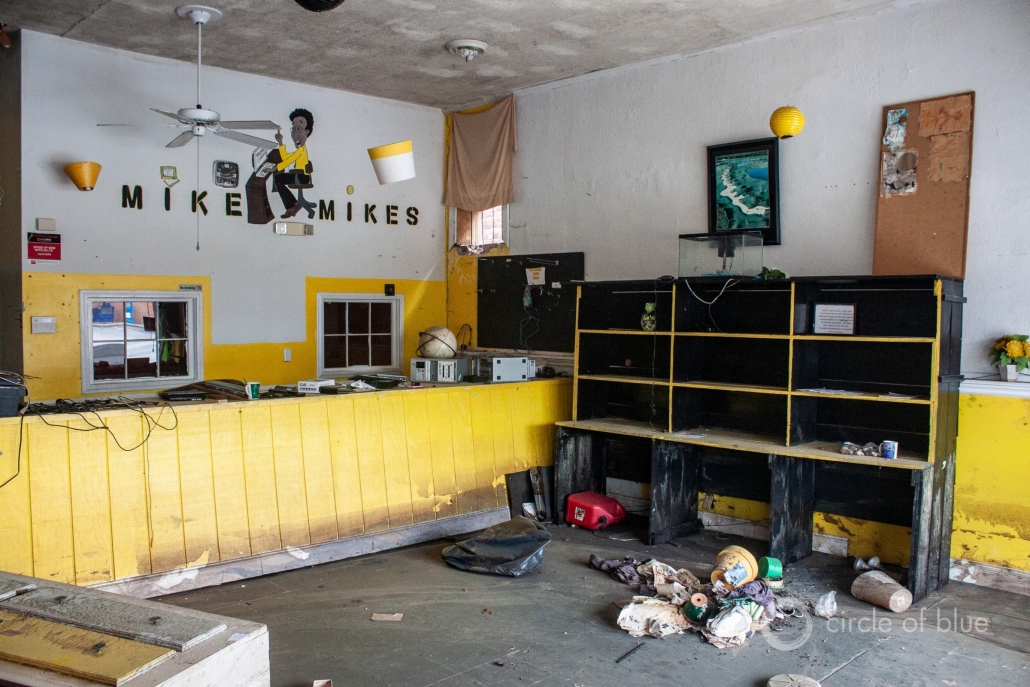
Mike Mike’s, a computer repair shop, is one of the many businesses along Fair Bluff’s Main Street that did not reopen after the floods. The store interior is filled with debris. Photo © Brett Walton/Circle of Blue
Flooded Again
Hurricane Florence came ashore on September 13, 2018, as a Category 1 storm, a plodding monster that brought an ocean of moisture to the Cape Fear and Lumber River watersheds. By the time the storm ran its course, between 20 and 36 inches of rain had fallen on southeastern North Carolina. It took two weeks for the water to recede in Fair Bluff. Residents felt like they were seeing a rerun. Hurricane Matthew had flooded the town to similar depth two years before. Both storms displayed a ferocity that residents had never experienced. The biggest recent storm to hit coastal North Carolina was Hurricane Floyd in 1999. It pushed only a couple inches of water onto Main Street.
Leonard, the town manager, was in Fair Bluff the day before Matthew and recalled the scene leading to the storm. “It had been raining heavily on and off for a couple of weeks, and the river was full, and I remember telling the town clerk, ‘You know, if this thing doesn’t turn out to sea, like they say it will, we may be in trouble.’ And by trouble I meant we may have to replace the carpet again.
“Well, the next time I was in town hall, I had chest waders on and I was with the fire department and the furniture was floating around in the building.”
Residents and businesses were still responding to the wreckage from Matthew when Florence flooded them again. Downtown today is empty. Yoko’s, a Japanese restaurant that was the only flooded business to reopen after Matthew, is closed. The eatery’s ceiling fans droop like wilted flowers and the paint is peeling. The owner says that he won’t renovate again. He’s moving the restaurant to Tabor City, a 20-minute drive to the southeast.
If it’s left up to the town treasury of Fair Bluff, there will be no recovery because we will struggle to keep the street lights on.” Al Leonard, town manager
The high-water mark from Florence is tattooed inside Mike Mike’s Computers, an abandoned repair shop where the yellow walls are mottled with mold. None of the commercial buildings had flood insurance, Leonard said. In the flooded section of town just one business has reopened: the U.S. Post Office. It may be the only one to do so.
Billy Hammond, mayor of Fair Bluff since December 2013, has lived in town for six decades. The Fair Bluff of the future, he said, will not look like the Fair Bluff of the past. There is chatter about moving the business district from Main Street to a location along Highway 904, about a half-mile away, on land that did not flood in either storm. For travelers through Fair Bluff, Highway 904 is the turnoff for Myrtle Beach, a major tourist destination. Keeping businesses along that road could capture some of the beach traffic, Hammond said.
The discussions, currently informal, will soon take official form. Residents and local leaders will have an opportunity to weigh in on the town’s direction. The state provided grant money to develop a town plan, a two-year process that will be carried out by the Council of Governments, a group that assists local governments with planning and development. Fair Bluff’s plan will review town ordinances and land use, and outline potential futures.
Leonard frequently reiterates that, even if there is consensus on a plan, the town’s finances constrain its capacity to carry it out. As other town relocations have shown — several towns moved from the shorelines of the Missouri and Mississippi rivers after the 1993 floods — it takes out-of-town money to make the switch. Lots of money.
“If it’s left up to the town treasury of Fair Bluff, there will be no recovery because we will struggle to keep the street lights on,” Leonard said. “We will struggle to keep a policeman and a police cruiser driving around at night. There’s probably not enough tax base left to do those things. And so to go out and say the local treasury’s going to build a park or the local treasury is going to build a new commercial center somewhere, that’s never going to happen.”

Bonnie Savage works at Johnny’s Drive-In, now the only restaurant in Fair Bluff. Her home damaged by the floods, Savage has been living with her brother in Cerro Gordo, a town 7 miles away, while she awaits federal money to rebuild. “This is family land, so we’re keeping it,” Savage said. Photo © Brett Walton/Circle of Blue
The Rural Dilemma
Fair Bluff took the brunt of these two storms, but the economic and demographic conditions that made it so vulnerable are just as apparent in Maine or Nebraska, Mississippi or Kansas. No municipality, even the best-insured, most economically powerful metropolitan regions, shoulders the entire burden of recovery and response. See the $50 billion aid package that Congress passed after Hurricane Sandy, or Texas’s $3 billion flood-protection plan after Harvey.
But small towns, so many in number and so great in basic needs, can be overlooked. David Swenson, an Iowa State University economist, has studied the rise and fall of rural fortunes for three decades. He is pessimistic about their trajectory even before the era of super storms.
In the 10 years following the Great Recession, some 70 percent of rural counties declined in population, according to Swenson’s examination of Bureau of Economic Analysis data. Columbus County, where Fair Bluff is located, is part of that group. The county’s population dropped by one percent in that time period.
Many rural towns with declining populations survive by depreciating their assets, Swanson said. It’s like running an old car into the ground by not scheduling routine maintenance and repairs.
“You can maintain a lot of it by using it up and abandoning it,” Swenson explained. “But when you get a disaster, all of a sudden all that property that was marginal but functionally valuable is worthless.”
For Fair Bluff, government generosity has helped to maintain and rebuild assets. The town received two U.S. Department of Housing and Urban Development grants totaling $5 million to replace old sewer lines that were taking on so much water that they threatened to bankrupt the town. The new lines have reduced infiltration and cut the town’s monthly sewer bill. The state is also covering the cost of replacing an apartment complex that was flooded.
Fair Bluff residents “cannot bring about recovery on their own,” Leonard told Circle of Blue. “I’ve said in every meeting I’ve been in and I’ve said to every citizen, maybe to my peril, the recovery in Fair Bluff will go as far as someone else’s money will take us.”
The resilience angle cannot be seen in isolation from the development challenges.” Michael Szönyi, Zurich Insurance
So far, other people’s money has kept Fair Bluff standing. State and federal agencies have pledged some $28.5 million to replace cracked sewer lines, generators, and public buildings, and to tear down or reconstruct damaged homes and an apartment complex. It’s an enormous sum for a town whose current annual budget is roughly $600,000.
After Matthew, the town submitted applications for FEMA’s hazard grant mitigation program for 71 flooded homes. The program has three outcomes for flooded homes. It buys out the most hazard-prone homes and tears them down, it elevates existing homes, or it demolishes homes and builds them higher.
Fair Bluff last summer was granted $8.2 million under the program for homes flooded during Matthew, half of which will be torn down. But work has started on only three homes. That slow pace is a point of irritation locally.
Keith Acree, a spokesman for the North Carolina Department of Emergency Management, which administers the program, said that the funds are not for addressing immediate needs. “It’s a long-term recovery process,” he told Circle of Blue. “It’s designed to get you out of the way of the next storm. It’s not designed to be an emergency relief program.”
How can small communities rebound from disasters? That is the central question in a post-Florence assessment carried out by Zurich Insurance and ISET, an international organization that works on disaster risk reduction.
What they found in North Carolina reminded them of work they had done in rural Nepal and Peru: communities were more isolated and had fewer economic opportunities than urban counterparts and needed more help. To use a policy buzzword of advocates for climate change adaptation, those communities were less resilient.
The two concepts go hand in hand, argues Michael Szönyi of Zurich Insurance. “The resilience angle cannot be seen in isolation from the development challenges,” Szönyi told Circle of Blue.
Development is what Leonard, who has worked in small-town management for more than three decades, calls the “rural dilemma.” Fair Bluff is one of five communities in Columbus County that he assists. In his line of work, dollars and cents are always front of mind. What businesses can a small town attract that will get the owner a return on investment? With the rise of online shopping and discount stores like Dollar General, it’s probably not going to be retail, Leonard argues.
“You can bank on your phone, you can renew an insurance policy on your phone, you can order something from Amazon, have it delivered to your front door on your phone,” he said. “They haven’t figured out how to do a haircut over the phone. And so you could probably have a beauty salon downtown.”
What else gets a return on investment in towns with a few hundred or thousand residents? Housing, Leonard said. “We still have people coming in to the small towns I work for and say, ‘I need a place to rent around here. Where can I rent?’ And it may be to save these storefronts from just falling in due to neglect, you’ve got to convert them to residential.”
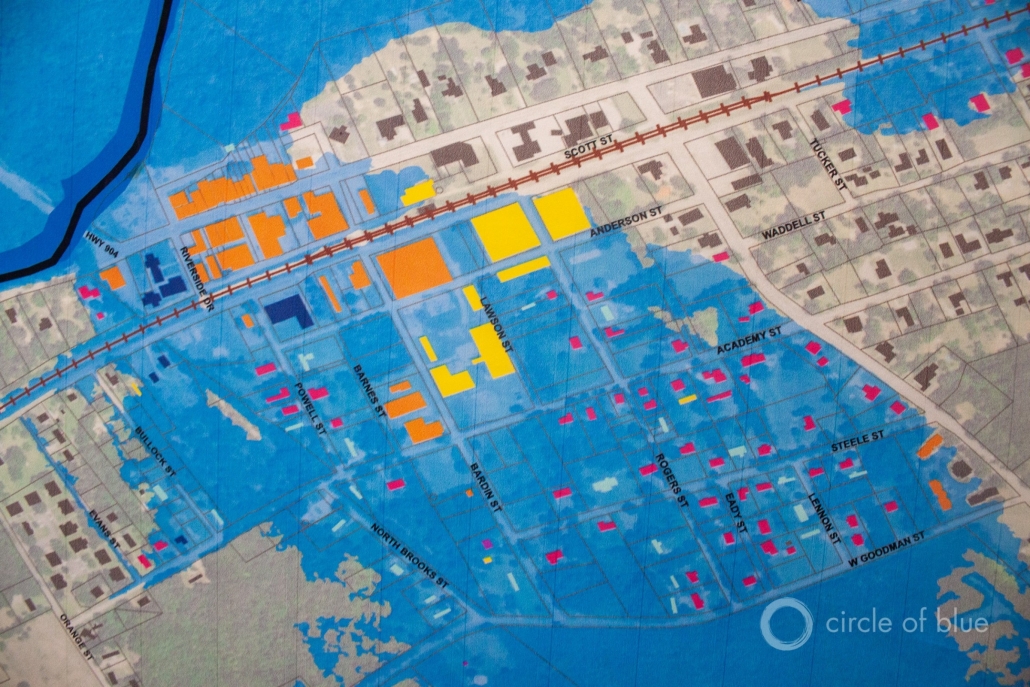
A map that hangs in the conference room of Fair Bluff’s rebuilt town hall shows, in blue, the sections of town that flooded during Hurricane Matthew. Commercial buildings are colored orange and homes are shaded pink. The dark squiggle in the upper left is the Lumber River. The same homes and businesses flooded again during Hurricane Florence. Photo © Brett Walton/Circle of Blue
Waiting To Go Home
Housing is something that could help Fair Bluff now. Those who lost their homes are getting impatient with the slow disbursement of Federal Emergency Management Agency reconstruction funds and are ready to move out of temporary arrangements.
“It’s been a hard, long, and difficult road for us,” Hammond, the mayor, said. “Because we’ve got people that lived here all their life and was flooded out of their house and primarily had nothing to come back to.”
Residents who were displaced took shelter where they could find it. Savage, who works at Johnny’s Drive-In, has been staying with her brother in Cerro Gordo, a town 7 miles away.
But others do not plan on coming back.
“A lot of people don’t want to go through that again, especially older people,” said Pittman. Pittman doesn’t view the river differently after the floods. To him, it’s the same water. But does he worry that the town, after all it’s been through, could be flooded again? “Oh yes, oh yes,” he said.
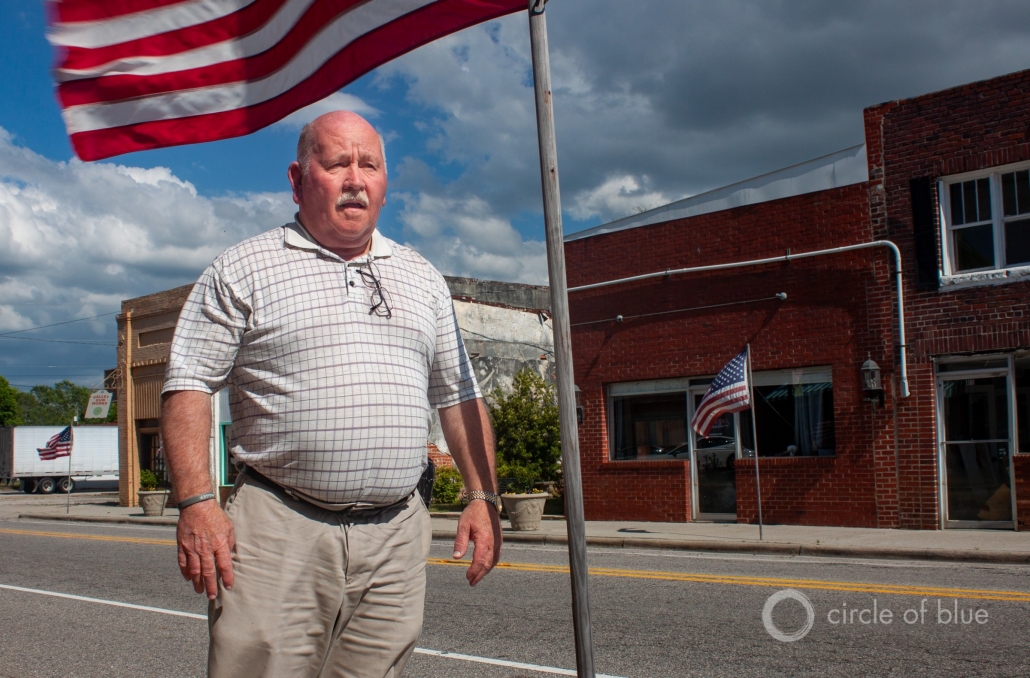
Billy Hammond, mayor of Fair Bluff, stands beside the town’s flag-lined Main Street. “We have a hard road ahead of us to recover and come back,” he said. Photo © Brett Walton/Circle of Blue
Future Paths
Lumber River State Park is a 15-minute drive from Fair Bluff. With boat ramps, picnic shelters, and several miles of hiking trails, the park is a popular site for family gatherings and fishing trips. It’s the type of recreation-based economy that Fair Bluff could exploit.
Within the park is the former site of Princess Ann, a town that formed in 1794 to serve as a transit hub along the river. By the mid-1800s, as railroads displaced river transport, Princess Ann began to wither. Soon it was gone. No buildings remain on the site today.
Ghost towns are a part of American history. Like Princess Ann, many were founded around an economy or resource — timber, coal, copper — that was eventually eclipsed or tapped out.
What’s different today, said Leonard, is the infrastructure. When a gold rush boom town went bust, it often did not have public water or public sewers. Prospectors packed up and left and associated business soon followed. But in Fair Bluff and elsewhere every resident who leaves places a greater burden on those who remain to pay for water treatment and other public services. That is the case for Fair Bluff’s remaining 600.
Because of them Fair Bluff is not quite dead. The annual Barbeque on the Bluff festival the last weekend in April drew a crowd of several hundred for two days of music and food. Residents embody the characteristics of personal resilience: a deep and genuine bond with their hometown and the resolve to endure. But for individual determination to prevail, it needs to be strapped to an economic engine, one that Fair Bluff does not currently possess.
Big questions and bigger decisions loom. How can the town attract residents? Will they arrive in time to be counted in the 2020 census, which sets the population basis for calculating state and federal budget subsidies? Just as important: what to do about Main Street?
With the memory of two floods still sharp, town leaders are confident that no one will want to open a business in derelict buildings. One possibility, in motion already in coastal communities in Alaska, Louisiana, and Washington that are increasingly vulnerable to sea level rise and flooding, is retreat. In Fair Bluff that means moving the business district to higher ground and ceding the current location to the river, perhaps as a public park that might lure tourists.
“The river tried to decimate us, so we’re going to use it,” Woody Strickland, a Fair Bluff resident, told Circle of Blue.
Fair Bluff residents, though pessimistic now, are not willing to see their town die.
“I was born and raised here,” Sharon Davis, who works at the fire department, told Circle of Blue. “It’s my hometown. I don’t want to see it wasted.”
“We’re the poster child right now for destruction,” Leonard reflected. “Maybe we’ll get you back in three or four years and show you a park where there used to be a downtown.”
Fair Bluff, in the end, may have to tear itself down before it can build itself back up.
Reporting for this article was made possible by a travel grant from the Institute for Journalism and Natural Resources.
Brett writes about agriculture, energy, infrastructure, and the politics and economics of water in the United States. He also writes the Federal Water Tap, Circle of Blue’s weekly digest of U.S. government water news. He is the winner of two Society of Environmental Journalists reporting awards, one of the top honors in American environmental journalism: first place for explanatory reporting for a series on septic system pollution in the United States(2016) and third place for beat reporting in a small market (2014). He received the Sierra Club’s Distinguished Service Award in 2018. Brett lives in Seattle, where he hikes the mountains and bakes pies. Contact Brett Walton
Related
© 2023 Circle of Blue – all rights reserved
Terms of Service | Privacy Policy



